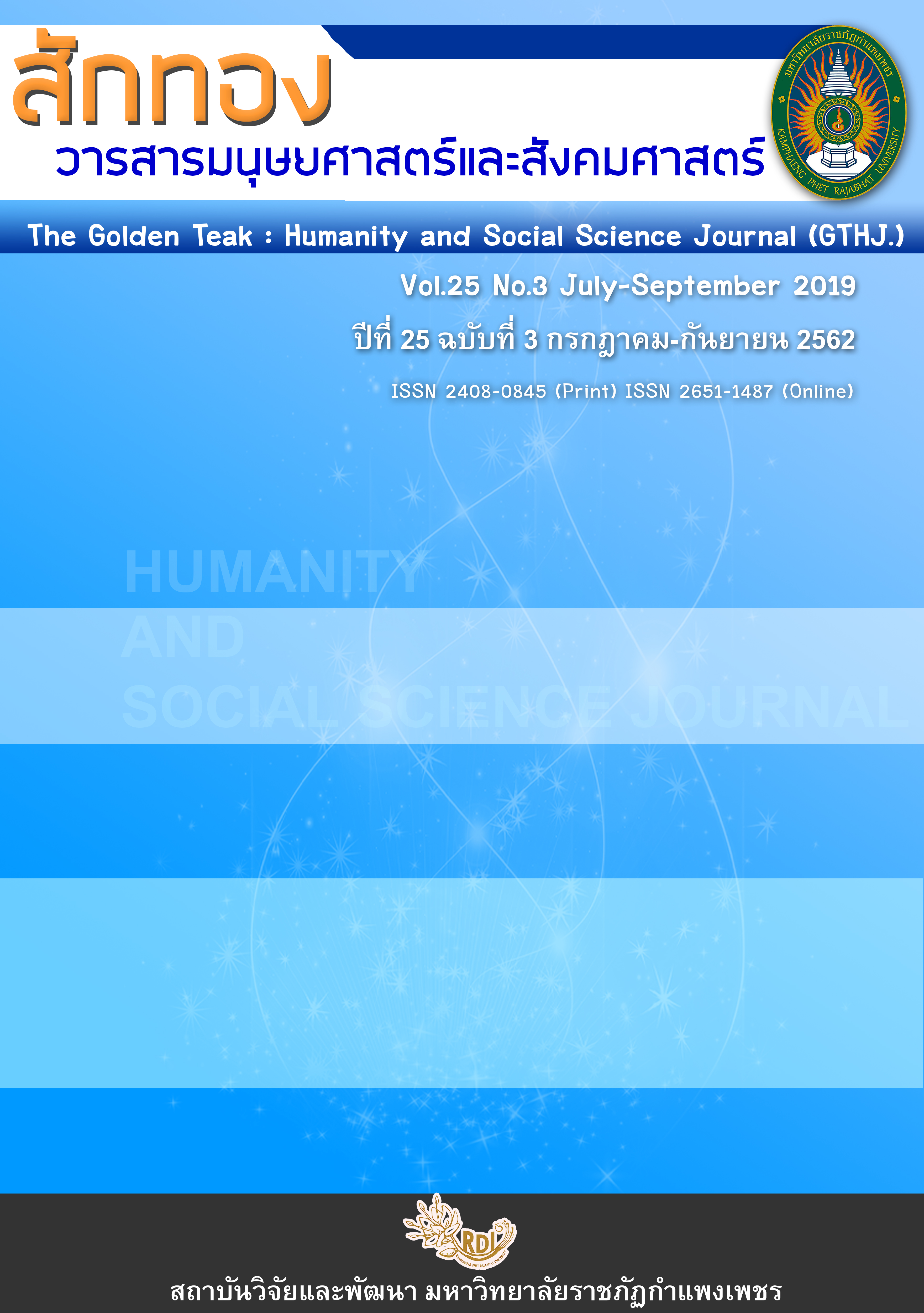Interpreting Cultural Heritage for Non-Thai Visitors in Hat Siao Community, Sukhothai Province, Thailand
Main Article Content
Abstract
This research is aimed to verify cultural identities and evaluate existing heritage resources of the community, to identify non-Thai visitors’ characteristics, expectations and acquire experiences and to develop effective cultural heritage interpretations for cross-cultural visitors in Hat Siao community. Both primary and secondary data were collected in a combination of research methods from December, 2014 to June, 2018. The literature review and documentation research were collected as the secondary data while field observations, questionnaires, in-depth interviews and a focus group were collected as the research primary data. Although cultural heritage resources in Hat Siao community embrace all aspects of the Burra Charter, its existing conditions which evaluated by the dimensions of authenticity from Hoi An Protocols has been changed by various forces. Nonetheless the non-Thai visitors in the community were from different demographic and psychographic groups, their expectations to visit Hat Siao community were largely for learning rather than having leisure experiences. Unfortunately, their experience to learn about the community cannot be fulfilled by the available heritage interpretation. Heritage interpretation is recognized as crucial tools to promote and conserve cultural heritage of Hat Siao community while improving visitors’ deeper learning experiences, providing them feel appreciate and engage their senses of heritage protection. To develop effective interpretation, the community should put more focus on emerging the key messages for cross-cultural visitors and find channels to transmit the messages to foreign visitors through off-site and on-site interpretation.
Article Details
บทความที่ได้รับการตีพิมพ์เป็นลิขสิทธิ์ของวารสาร สักทอง : วารสารมนุษยศาสตร์และสังคมศาสตร์ สถาบันวิจัยและพัฒนา มหาวิทยาลับราชภัฏกำแพงเพชร
ข้อคิดเห็นใดๆ ที่ปรากฎในวารสารเป็นวรรณกรรมของผู้เขียนโดยเฉพาะ ซึ่งมหาวิทยาลัยราชภัฏกำแพงเพชรและบรรณาธิการไม่จำเป็นต้องเห็นด้วย
References
for places of cultural significance. [Online]. Available : http://australia.icomos.org/
publications/charters/ [2015, May 30].
Beck, L. & Cable, T.T. (1998). Interpretation for the 21st Century: Fifteen guiding principles
for interpreting nature and culture. Champaign, ILL. Sagamore Publishing.
George, E. W. (2005). Commodifying local culture for rural community tourism development :
Theorizing the commodification process. The Eleventh Canadian Congress on
Leisure Research, Department of Recreation and Tourism Management. Nanaimo.
B.C. : Malaspina University-College.
Hall, M. & McArthur, S. (1996). Heritage management in Australia and New Zealand: The
human dimension. (Eds.). Melbourne, Vic; Aucland, NZ : Oxford.
ICOMOS. (2008). Charter for the interpretation and presentation of cultural sites. [Online].
Available : http://www.internation.icomos.org/charters/interpretation_e.pdf
[2015, February 26].
Lancaster County Planning Commission. (2001). Telling our stories : An interpretation
manual for heritage partners. [Online]. Available :
https://lancastercountyplanning.org/DocumentCenter/Home/View/134
[2016, February 26].
Martin, K. (2010, April). Living pasts-contested tourism authenticities. Annuals of Tourism
Research, 37(2), 537-554.
Medina, L.K. (2003, April). Commoditizing culture-Tourism and Maya identity. Annuals of
Tourism Research, 30(2), 345-368.
Panirf, O. (2010). Resettlement and adaptability of Tai-Phuan Ethnic: from Xieng Khouang, the
Lao PDR to the central Region of Thailand. The 5th International Seminar on
Vernacular Settlements. Sri Lanka : University of Moratuwa.
Poria, Y., Reichel, A. & Biran, A. (2006, February). Heritage site perceptions and motivations to
visit. Journal of Travel Research, 44(3), 318-326.
Pröschel, N. (2012). Commodification and culture: How can culture be economically used
without selling it out?. Bachelor Thesis, Modul Vienna Univeristy.
Staiff, R. (2014). Heritage and tourism interpretation. [Class handout]. Bangkok : Silpakorn
University.
Taylor, J.P. (2001, January). Authenticity and sincerity in tourism. Annuals of Tourism
Research, 28(1), 7-26.
UNESCO Bangkok. (2009). Hoi An Protocols for best conservation practice in Asia :
Professional guidelines for assuring and preserving the authenticity of heritage
sites in the context of the cultures of Asia. [Online]. Available :
http://unesdoc.unesco.org/images/0018/001826/182617e.pdf [2016, October 20].


